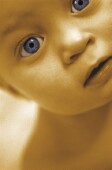
WEDNESDAY, Nov. 6 (HealthDay News) — At least one sign of autism may begin as early as 2 months of life, new research suggests.
The study of 110 babies found that infants later diagnosed with autism showed a decline in the amount of attention they paid to other people’s eyes beginning at 2 months and continuing until 24 months.
“We found that signs of autism are measurable and observable within the first months of life,” said study author Warren Jones, director of research at the Marcus Autism Center at Children’s Healthcare of Atlanta.
“These are the earliest signs of autism ever observed,” Jones said, noting they may be associated with symptom severity.
Children with autism have impaired communication and social skills and often exhibit repetitive behaviors. Symptoms may be mild, as in Asperger syndrome, or severe, as in full-blown autism. It’s estimated that one in 88 U.S. children has an autism spectrum disorder.
Despite the observed decline in eye attention, the researchers said infants later diagnosed with autism did pay more attention to people’s eyes than was expected.
“This insight, the preservation of some early eye-looking, is important because, in the future, if we were able to use similar technologies to identify early signs of social disability, we could then consider interventions to build on that early eye-looking and help reduce some of the associated disabilities that often accompany autism,” said Jones.
Autism therapies work best when begun while the brain is still developing. “This early developmental window may be an opportunity to intervene that we didn’t know we had before,” Jones added.
The findings, released online Nov. 6 as a letter in the journal Nature, need to be confirmed in larger studies before they can lead to changes in clinical practice.
Deficits in eye contact are a key sign of autism spectrum disorders, according to background information in the study. But it wasn’t clear when such deficits begin.
Currently, autism is often diagnosed using a scientifically validated checklist designed for youngsters between 16 months and 30 months old, according to Autism Speaks.
For the study, the researchers enrolled 59 babies considered to be at high risk of developing an autism spectrum disorder because they had a sibling with autism. Another 51 babies were enrolled who were considered low-risk.
To see if they could pinpoint when lack of interest in other people’s eyes begins, the research team used eye-tracking technology to measure the babies’ focus when shown videos of caregivers engaged in normal behaviors.
The babies were shown the videos at 10 time points between 2 months and 2 years of age.
By age 3, just one child from the low-risk group was later diagnosed with an autism spectrum disorder, compared to 12 youngsters in the high-risk group. Because just two of these children were female, the researchers limited their analysis to the 11 male children diagnosed with autism. They compared them to 25 typically developing children from the low-risk group.
The researchers noted that the decline in interest in other people’s eyes began at 2 months and continued declining until 2 years.
One expert called the findings a significant advance.
“This was a very well-done, very revealing study documenting in a precise and systematic way that children who are later diagnosed with autism spectrum disorders have demonstrable and progressive differences in visual regard in infancy. It’s a breakthrough finding,” said Dr. Andrew Adesman, chief of developmental and behavioral pediatrics at Steven & Alexandra Cohen Children’s Medical Center of New York in New Hyde Park, N.Y.
“Whether this might permit accurate and reliable diagnosis earlier is still very unclear. But if it does lead to earlier identification, it may lead to the development of earlier interventions,” he said.
Jones pointed out that these deficits aren’t something that parents would be able to see on their own. “This is not something a parent can see by just holding a baby. We collected many measurements over time,” he explained.
“Parents shouldn’t be concerned if their babies aren’t looking at them 100 percent of the time, but if they do have persistent concerns, they should talk to their child’s pediatrician,” advised Jones.
More information
The U.S. Centers for Disease Control and Prevention offers advice on what to do if you’re concerned about your child’s development.
Copyright © 2024 HealthDay. All rights reserved.

